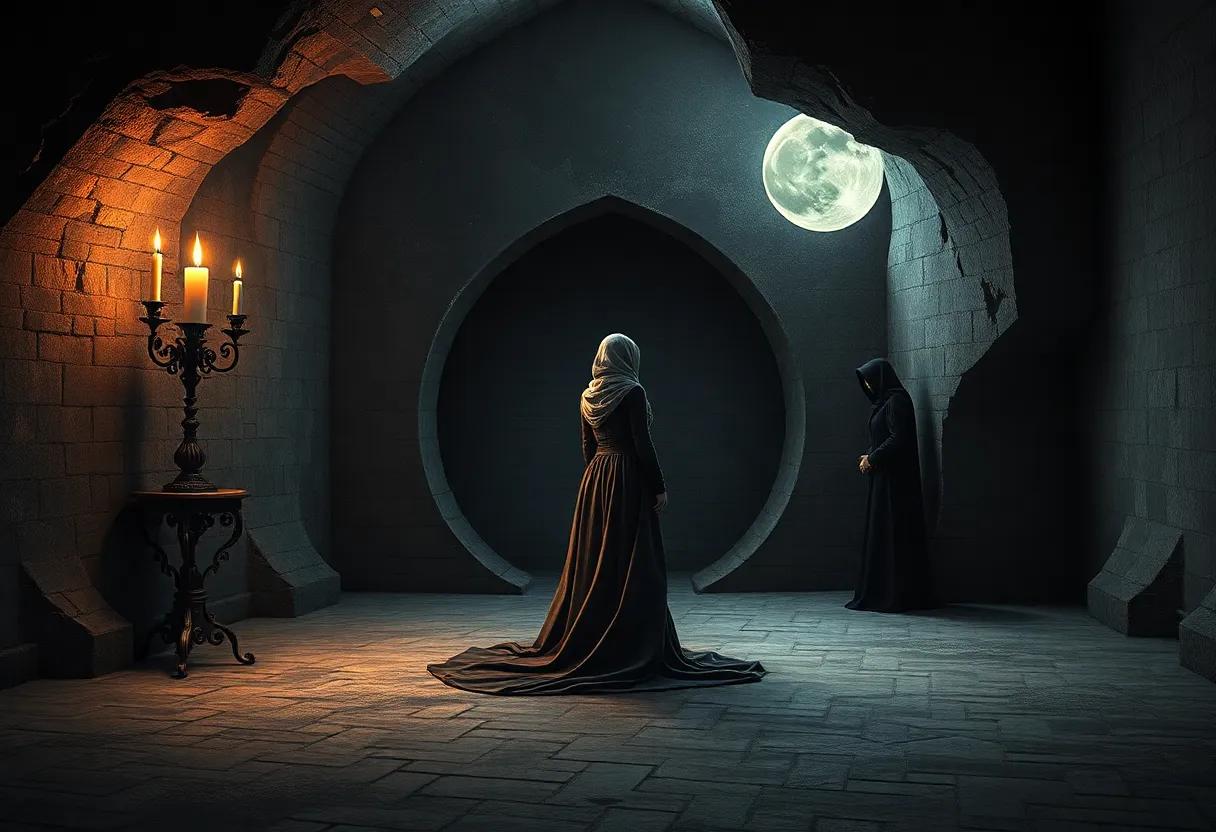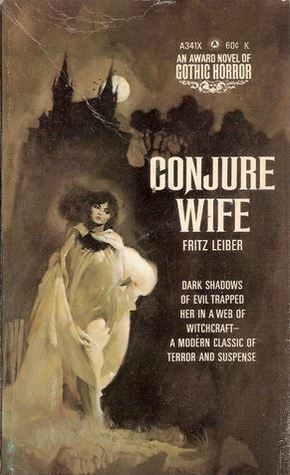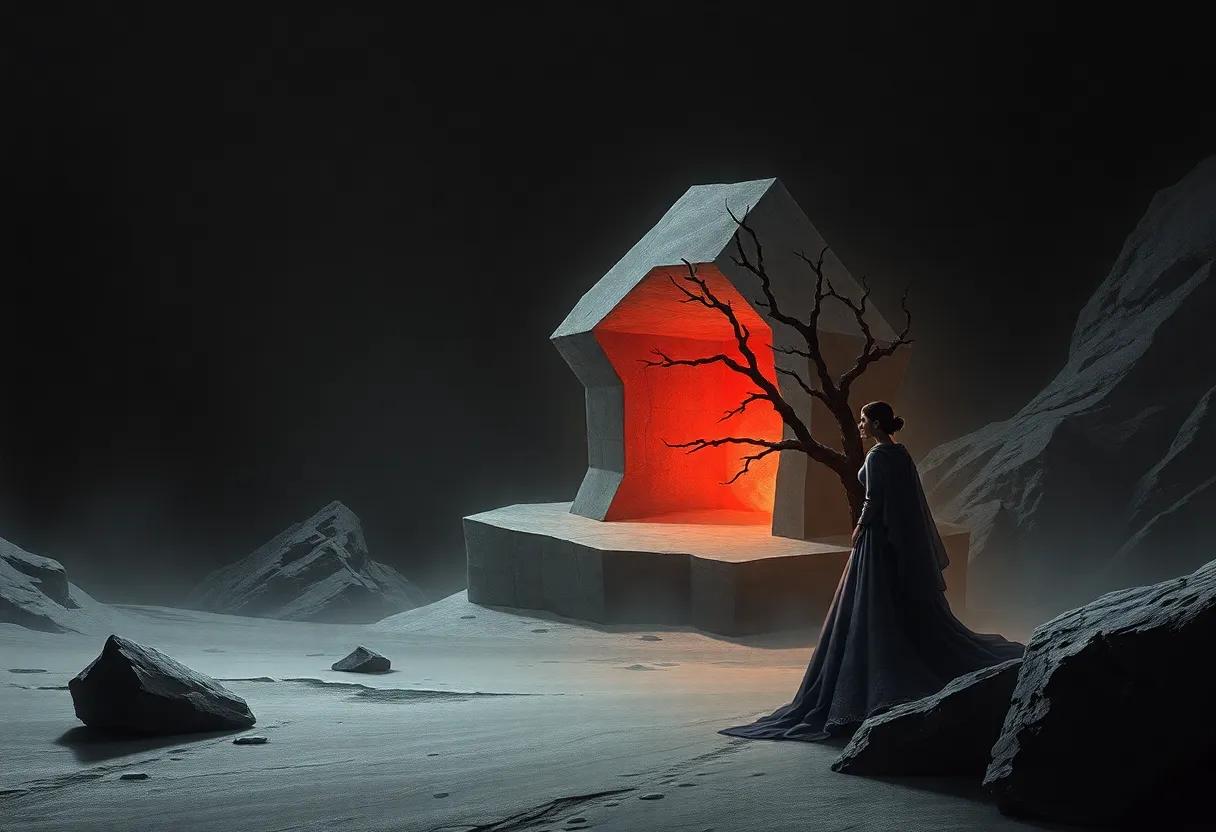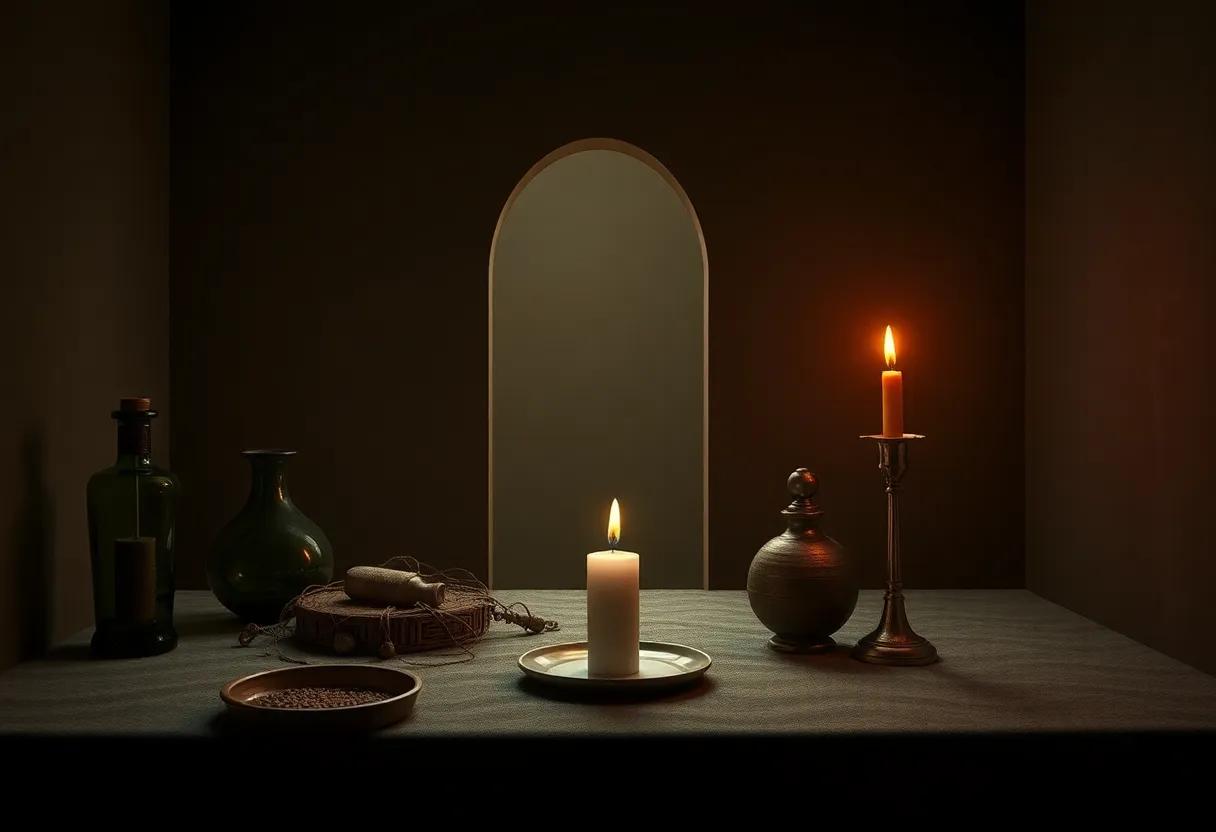In the shadowy crossroads where folklore entwines with human psychology, Fritz Leiber’s Conjure Wife emerges as a compelling exploration of witchcraft, superstition, and the subtle mechanics of paranoia. Since its publication, the novel has intrigued readers by peeling back the veneer of everyday life to reveal the mysterious rituals quietly shaping reality. This review delves into Leiber’s deft weaving of suspense and social critique, inviting readers to reconsider the boundaries between belief and fear, magic and madness. Through a measured lens, we explore how Conjure Wife continues to captivate and unsettle, decades after its first spell was cast.
Unraveling the Intricacies of Witchcraft and Folklore in Fritz Leiber’s Conjure Wife and Its Cultural Implications

Fritz Leiber’s Conjure Wife captures the fragile intersection between the visible world and the shadowy realm of folk magic, inviting a multifaceted exploration of both witchcraft and cultural anxieties. The novel’s nuanced portrayal transcends mere supernatural thrills, instead weaving in a complex tapestry of paranoia, societal pressure, and tradition. The enchanted trinkets and whispered spells become symbolic artifacts of a larger cultural dissonance – illustrating how folklore permeates deeply into the fabric of modern life, often unseen but powerfully present.Leiber deftly questions what happens when the private rituals of women collide with the rigid, skeptical structures of academic and scientific authority.
At its core, the book reveals a subtle commentary on the nature of belief and the cost of secrecy, underpinned by vivid cultural contrasts. Consider the following elements that Leiber threads through the narrative:
- Hidden Power - The seemingly innocuous charms and rituals wield tangible influence,challenging assumptions about magic as mere superstition.
- Gender Dynamics – Witchcraft serves as a metaphor for female autonomy in a patriarchal society that dismisses and undermines women’s knowledge.
- Collective Fear – Paranoia does not arise solely from witchcraft itself, but from the fear of that which is unknown or suppressed.
| Element | Cultural Implication |
|---|---|
| Witchcraft as Tradition | Preservation of identity and unspoken female heritage |
| Academic Skepticism | Clash between modern rationalism and old world mysticism |
| Paranoia and Surveillance | Reflection of Cold War era anxieties and distrust |
Exploring the Atmosphere of Suspense and Paranoia that Drives the Narrative and Shapes Character Perspectives in the Novel
the narrative’s progression is punctuated by moments where the boundaries between rationality and superstition blur,amplifying the psychological strain. Consider the dynamic interplay among characters, highlighted in the table below, which showcases how paranoia shapes their worldviews and actions:
| Character | Perspective on Witchcraft | Manifestation of Paranoia |
|---|---|---|
| Tamsin | Pragmatic denial | Feels constant threat from unseen forces |
| Norman | Skeptical rationalism challenged | Obsessive investigation into wives’ behaviors |
| supporting Wives | Secret practitioners | guarded, deceptive social masks |
Leiber’s skillful use of suspense is amplified through the narrative’s careful pacing and the characters’ gradual unraveling.Suspicion is a relentless drumbeat, convincing the reader that beneath the surface of normalcy lies a hidden world where superstition ignites distrust and fractures relationships. This ever-present tension not only propels the story but also invites readers to ponder the fragile line between belief and fear in human nature.
Analyzing the Role of Gender Dynamics and Societal Expectations within the Context of Mid-Century Superstition and Fear
In Conjure Wife, Fritz Leiber masterfully exposes the intricate web of gender dynamics underpinning mid-century paranoia, painting a vivid picture of how societal expectations shape perceptions of power and vulnerability. Women, often portrayed as the secret bearers of superstition, symbolize a threatening undercurrent to the patriarchal order, as their covert use of witchcraft challenges the rational, male-dominated world. Leiber doesn’t merely depict witches as isolated individuals; rather,he situates them within a broader cultural framework where fear of the feminine intersects with entrenched anxieties about control and authority.
The societal expectations placed on women manifest in multifaceted ways throughout the narrative, emphasizing both the limitations and subversive potentials of their roles.Below is an outline of key gendered themes highlighted in the novel:
- Hidden Influence: women’s magic serves as a metaphor for unacknowledged agency beneath public submissiveness.
- Double Standards: Superstition condemns women for behaviors overlooked or rationalized in men.
- Fear of Female knowledge: The threat posed by women’s secret wisdom unsettles societal equilibrium.
- Repression and resistance: Gender norms force women into concealment, fostering an underground culture of defiance.
| Gender Role | Societal Expectation | Impact on Fear |
|---|---|---|
| Women | Submissive,Silent | Viewed as mysterious,potentially dangerous |
| Men | Rational,Dominant | Struggle to control irrational fears |
| Witches | Hidden power-brokers | Source of paranoia and projection |
How Conjure Wife Blends Elements of Horror,Fantasy,and Psychological Thriller to Create a Unique Reading Experience
Fritz Leiber’s Conjure Wife is a masterful fusion where the eerie tendrils of horror entwine seamlessly with the enchanting allure of fantasy, all while unraveling the intricate layers of the human psyche. The novel doesn’t merely frighten; it unsettles by weaving everyday marital life with the supernatural presence of witchcraft. This blend magnifies the tension, as readers are drawn into a world where the unseen forces manipulate reality, leaving characters-and readers-questioning what is real and what is illusion. Leiber’s portrayal of witchcraft transcends typical fantasy tropes, serving as a psychological mirror reflecting the fears, paranoia, and insecurities lurking beneath the mundane.
what truly sets the narrative apart is its layered approach to suspense and dread, punctuated by moments that challenge both logic and belief. Through a carefully paced unraveling,tension escalates not solely from external threats but from internal conflicts,creating a nuanced interplay between mind and magic. Consider this brief breakdown of thematic elements and their narrative roles:
| Element | Role in the Story | Effect on Reader |
|---|---|---|
| Horror | Introduces fear through supernatural events | Elicits unease and suspense |
| Fantasy | Builds an alternate reality with witchcraft | Engages imagination and wonder |
| Psychological Thriller | Explores paranoia and mental unraveling | Provokes introspection and tension |
- Atmospheric tension: Leiber captures the subtle dread that seeps into daily life, making the ordinary terrifying.
- Character depth: The protagonists’ internal struggles mirror the external supernatural chaos,enriching the emotional landscape.
- blurred reality: The book thrives on ambiguity, keeping the reader perpetually off-balance regarding what is supernatural and what is psychological.
The Symbolism Behind Everyday Objects and Rituals That Embody the Supernatural and the Unknown in the Story
In Conjure Wife, everyday objects take on a chilling duality, transforming from mundane household items into potent talismans that tether characters to unseen forces. The seemingly innocent objects-salt placed around doorways, a seemingly unremarkable pin, or a carefully hidden charm-are imbued with layers of meaning that blur the line between superstition and reality. These items serve not only as physical anchors of protection but also as symbols of deep-seated fears and unspoken anxieties about control and vulnerability within domestic life. The rituals surrounding these objects, often performed in whispered secrecy, elevate them from mere tools to conduits of power, suggesting that the real magic lies not just in the object itself but in the belief and intent invested in it.
- Salt: Symbolizes purification and warding off evil, a fragile barrier between order and chaos.
- Charm bags: Represent hidden knowledge and the clandestine nature of feminine power.
- Ritual incantations: Echo the persistence of ancient wisdom within modern skepticism.
As the story unfolds,the interplay between these tangible symbols and the intangible forces they represent creates a suspenseful atmosphere where paranoia thrives. The rituals surrounding the objects are meticulously detailed, revealing how they function as more than superstition-they become psychological safeguards, both empowering and imprisoning the individuals who depend on them. Through the contrast of everyday normalcy and occult undertones,Fritz Leiber crafts a world where the unknown lurks just beneath the surface,reminding readers that the supernatural often wears the guise of the familiar.
| Object | Symbolic Meaning | Ritual Use |
|---|---|---|
| salt | Purification, protection | sprinkled around doorways |
| Charm bag | Hidden power, secrecy | Carried or hidden in home |
| Pin | Defence against harm | Placed in clothing or walls |
Assessing the Impact of Leiber’s Narrative Style on Pacing and Tension in Unveiling Hidden Threats and Secrets
Leiber’s narrative technique in Conjure Wife masterfully orchestrates the rhythm of the story, allowing tension to simmer beneath the surface before erupting unexpectedly. Rather than relying on straightforward exposition, his use of subtle hints and fragmented revelations keeps readers in a constant state of alert curiosity. This method enhances the unfolding of hidden threats and secrets,making every scene feel charged with the possibility of danger or betrayal. His prose is economical yet evocative, layering ordinary domesticity with an undercurrent of unease that steadily accelerates the sense of urgency as the story progresses.
notably, Leiber’s balancing act between pacing and atmosphere can be outlined through key narrative devices:
- Shifting perspectives: providing glimpses into various characters’ motivations without full disclosure.
- Incremental reveals: slowly unveiling the supernatural elements embedded in everyday life.
- Dialogues laden with subtext: conversations that hint at paranoia without overt accusations.
- Strategic pauses: moments of quiet reflection that heighten anxiety.
| Technique | Effect on Pacing | Impact on Tension |
|---|---|---|
| Fragmented Revelations | Maintains steady momentum | Creates suspense and mystery |
| Subtextual Dialogue | Slows dialogue for weight | Builds psychological unease |
| Atmospheric Details | Punctuates narrative beats | Deepens creeping dread |
Comparing Conjure Wife to Contemporary Works and Its Influence on Later Witchcraft and Horror Literature
Fritz Leiber’s Conjure Wife stands as a distinctive beacon among mid-20th-century witchcraft narratives, diverging from the more overtly supernatural or folkloric approaches of its contemporaries. Unlike works such as Shirley Jackson’s The Haunting of Hill House or Ray Bradbury’s Something Wicked This Way Comes, which delve deeply into atmospheric dread and external hauntings, Leiber’s novel internalizes fear through the lens of social paranoia and secret domestic rituals. The concept of everyday witchcraft lurking beneath the veneer of mundane college life creates a unique tension that influenced how later authors approached the intersection of magic and psychology, blending the supernatural with the subtle terror of suspicion and mistrust.
Its impact resonates through subsequent decades, inspiring authors who explore the shadowy boundaries between belief and reality. Writers such as Stephen King, whose works often intertwine domestic spaces with unsettling supernatural elements, echo the quiet but persistent unease that Leiber pioneered. more broadly, Conjure Wife contributed to a shift in horror literature - moving away from grand, mythic evocations of witchcraft toward intimate examinations of power, gender, and secrecy in everyday settings. Below is a brief comparison table illustrating Leiber’s novel alongside key contemporary works and their thematic focuses:
| Title | Author | Primary Focus | Contribution to Genre |
|---|---|---|---|
| Conjure Wife | Fritz Leiber | Domestic Witchcraft & Paranoia | Subtle psychological horror & gender dynamics |
| the Haunting of Hill House | Shirley Jackson | Psychological Haunting | Atmospheric ghosts & mental instability |
| Something Wicked This Way Comes | Ray Bradbury | Supernatural carnival | Blend of fantasy & horror, childhood fears |
| Rosemary’s Baby | Ira Levin | Satanism & Trust | Modern urban witchcraft paranoia |
- Innovative domestic focus: Witchcraft as a hidden, everyday threat rather than a distant myth.
- Psychological complexity: Characters caught between skepticism and belief amplify tension.
- Gender commentary: Examination of power relationships through the lens of witchcraft accusations.
Recommendations for Readers Interested in Occult Themes and Complex Character-Driven Plots in Classic Genre Fiction
Recommended Reads for Fans of Complex Occult Themes and Character-Driven Narratives:
- Nightmare Alley by William Lindsay Gresham – a descent into the human psyche cloaked in carnival mysticism
- The Haunting of Hill House by shirley Jackson - where haunting is as much about personal fear as spectral presence
- we Have Always Lived in the Castle by Shirley Jackson – a portrait of isolation, family secrets, and psychological tension
- Something Wicked This Way Comes by Ray Bradbury – blending childhood fears with dark enchantment through richly drawn characters
| Aspect | Why It resonates | Leiber’s Distinctiveness |
|---|---|---|
| Character Complexity | Multi-layered personalities facing moral dilemmas | Focus on the ordinary husband’s unraveling psyche |
| Occult Elements | Subtle magic woven into everyday life | Realism intertwined with supernatural suspicion |
| Atmospheric Tone | Maintains sustained suspense and paranoia | Psychological dread over cheap horror moments |
The Lasting Relevance of conjure Wife in Modern Discussions About paranoia, Belief, and Power Structures
Fritz Leiber’s Conjure Wife intricately explores the persistent grip of paranoia and belief systems that transcend its supernatural premise, making it profoundly relevant in contemporary analysis of societal power dynamics. The novel deftly unveils how invisible forces-whether construed as witchcraft or institutionalized suspicions-shape behavior, often more through the fear of exposure than any tangible proof. This dynamic mirrors modern realities where conspiracy theories and systemic distrust ripple through communities, influencing decisions and hierarchies. Leiber’s portrayal of clandestine rituals as metaphors shines a light on the unspoken agreements and fears fueling control within both intimate relationships and broader societal frameworks.
In evaluating power structures through the lens of Conjure Wife,one notices how belief-regardless of its empirical basis-acts as a currency of influence. The novel’s charm lies in illustrating that paranoia is not simply a byproduct of ignorance but a mechanism that can entrench power or destabilize it. This is encapsulated in the table below, which outlines key elements linking the novel’s themes to real-world analogues:
| theme | Literary Depiction | Modern Parallel |
|---|---|---|
| Fear of the Unknown | Secret witchcraft rituals | Conspiracy theories in media |
| Control through Belief | Magical influence over spouses | Manipulation via ideology or propaganda |
| Paranoia as Power | Distrust among academics | Political surveillance and suspicion |
| Invisible Structures | Unseen spells affecting reality | Opaque institutional hierarchies |
A Close Look at Fritz Leiber’s Literary Career and the Enduring Legacy of His Contributions to Speculative Fiction
Fritz Leiber’s literary career stands as a beacon of innovation within speculative fiction, seamlessly blending psychological depth with supernatural elements. His work defies easy categorization,oscillating between fantasy,horror,and science fiction while maintaining a consistent focus on human vulnerability in extraordinary circumstances. In Conjure Wife, leiber masterfully explores the undercurrents of paranoia and the unnerving presence of folk magic in everyday life. What makes his storytelling enduring is his ability to inject the fantastical into the mundane, revealing how ancient superstitions clash with modern rationalism, and in doing so, he taps into a timeless fear of the unknown lurking just beyond reason.
Leiber’s influence extends far beyond the bounds of genre fiction, inspiring countless authors and creators across diverse media, and shaping the narrative approach to both horror and fantasy. His ability to construct multi-dimensional characters entangled in webs of belief and skepticism remains influential. Below is a brief overview of thematic pillars central to his legacy:
- Psychological complexity: Characters grappling with paranoia and self-doubt.
- Blurring of genres: Seamless integration of horror, fantasy, and science fiction.
- subversion of norms: Challenging societal and epistemological boundaries.
- Exploration of occult: Folklore and witchcraft as metaphors for power and fear.
| decade | Notable Works | Influence |
|---|---|---|
| 1940s | Swords and Deviltry, Conjure Wife | Innovation in fantasy & heartfelt horror |
| 1950s | The big Time, The Wanderer | Expansion of science fiction themes |
| 1960s | Swords Against Death, Swords in the Mist | Defining sword and sorcery subgenre |
| 1970s | Ill Met in Lankhmar, Our Lady of Darkness | Psychic horror and urban fantasy fusion |
In peeling back the layers of Fritz Leiber’s Conjure Wife, we traverse a shadowed world where superstition interlaces with everyday existence, casting long, unnerving shadows over the lives within. This novel not only conjures an eerie atmosphere but also probes the fragile boundaries between belief and paranoia, inviting readers to ponder how much of our reality is shaped by unseen fears and hidden rituals. Whether approached as a chilling tale of witchcraft or a subtle commentary on human psychology, Conjure Wife remains a compelling work that lingers long after the final page is turned-an enigmatic spell that both haunts and intrigues.





